

The push to increase energy efficiency and reduce emissions continues to drive change in the HVAC industry. As a result, the government is instituting significant changes in energy efficiency criteria and ratings for both residential and commercial equipment.
Rather than viewing the regulatory changes as a problem to be solved, Rheem is embracing them as an opportunity to innovate new technologies to create an even better product line for contractors and homeowners.
To help you understand what’s changing, why, and how it’ll affect you, we’re pleased to bring you this HVAC KnowZone™ to act as a central hub, where you can easily access information as it becomes available. We will continue to make updates to the HVAC KnowZone as new information becomes available.
Natural Resources Canada (NRCan) has published Energy Efficiency Regulations Amendment 17 which updates the energy efficiency and testing standards for residential split system central air conditioners and central heat pumps.
The required compliance date for Canada is January 1st, 2023.
NRCan rule is generally aligned with the U.S. Department of Energy (DOE) on use of the efficiency metrics of SEER2, EER2, and HSPF2 as described in Appendix M1.
Download our Rheem Canada FAQ sought to address our positioning on the next generation of refrigerants.
For equipment manufactured after January 1, 2023, the minimum standards are changing, and a new test procedure is also being required.

When it comes to training and certifications, everyone connected to the HVAC industry benefits —contractors, technicians and even homeowners.
North American Technician Excellence (NATE) is the nation’s largest nonprofit certification organization for heating, ventilation, air conditioning and refrigeration (HVACR) technicians. Headquartered in Arlington, VA, NATE was developed by and has been supported by the industry for over 20 years.
ENERGY STAR® is the government-backed symbol for energy efficiency and provides simple, credible and unbiased information that consumers and businesses rely on to make well-informed decisions that help them save money and protect the environment.
Learn More
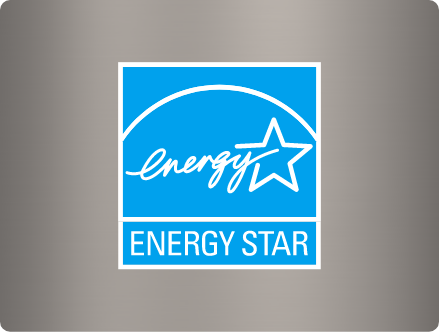
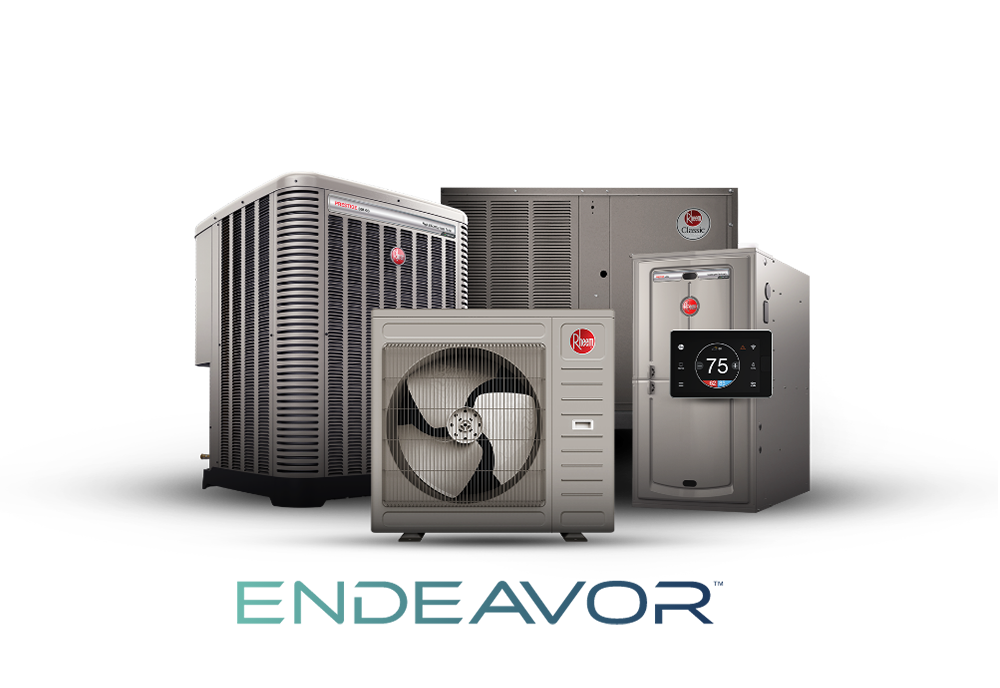
As the new NRCan Requirements Take Effect Jan. 1, 2023, Rheem will be ready with the all-new
Endeavor™ Line of Furnaces, Air Conditioners, Heat Pumps and Air Handlers. So even as
regulations get tougher, your job gets easier.
Endeavor Features & Benefits
On April 2nd, 2022, Natural Resources Canada (NRCan) pre-published M1 Amendment 17 with requirements in the
Canada Gazette, updating energy efficiency and testing standards for central air conditioners and
central heat pumps used in residential. The expectation is that effective January 1 2023, newly
manufactured residential and light commercial equipment sold in Canada will be required to meet these
new M1 minimum efficiency standards.

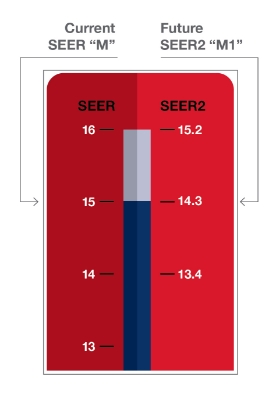
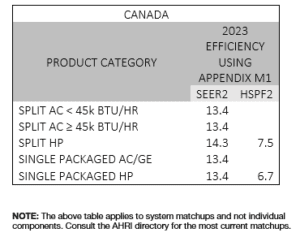
As provided by NRCAN on Amendment 17 Published April 2022
Executive Summary: as provided by the Canada Gazette. Issues: Canada’s building sector
(including homes and commercial and institutional buildings) is a significant contributor to
Canada’s total energy consumption and greenhouse gas emissions, especially for space and water
heating. Regulating the energy use of products is one of many tools available to the Government to
reduce energy consumption and support the goal of net-zero emissions by 2050. Nevertheless,
unnecessary regulatory differences across jurisdictions can hinder cross-border trade and investment
and ultimately impose a cost on citizens, businesses, and economies. In this context, regulatory
actions are necessary at this time to keep pace with changes that have been done in the United
States, and to put in place tools that will facilitate maintaining alignment in the future.
Description: This proposed amendment (the Amendment) would update energy efficiency and
testing standards for central air conditioners and central heat pumps primarily used in the
residential sector to prevent upcoming unnecessary regulatory differences between Canada and the
United States. In addition, the Amendment would make other minor changes to currently regulated
products to address known issues with Canadian requirements to ensure that the Energy Efficiency
Regulations, 2016 (the Regulations) align with the U.S. requirements more clearly where already
intended.
Finally, the Amendment would specify energy-using products in order for the Minister of Natural
Resources (the Minister) to be able to exercise the ministerial regulations authority, at his
discretion, to maintain harmonization between requirements set out in another jurisdiction.
Rationale: The Amendment would benefit Canadians by reducing energy consumption and resulting
greenhouse gas emissions of products used in homes. Homeowners will benefit from reduced energy
costs associated with the use of more efficient technologies. The Amendment would also avoid
misalignment with the United States Department of Energy and facilitate future efforts to maintain
alignment for products where a requirement (energy efficiency standards, testing standards, or
information) is aligned with that of another jurisdiction. Throughout the development of the
Amendment, stakeholders were provided several opportunities to comment on the changes being
considered. Overall, stakeholders are supportive of the Amendment and recognize its potential
benefit for consumers, utility programs, and climate change.
The present value of the net benefits of the Amendment is estimated to be about $1.68 billion by
2050, with total benefits exceeding total costs by a ratio of more than 5:1. By 2050, the present
value of benefits and costs from the Amendment is estimated to be about $2.06 billion and $374.27
million, respectively. On an annualized average basis, this equates to benefits and costs of about
$110 million and $20 million, respectively. The Amendment is estimated to result in a total annual
reduction of energy consumption in Canada of about 2.1 petajoules in 2050, resulting in total
greenhouse gas emission reductions of approximately 3.9 megatonnes of carbon dioxide equivalent by
2050. The quantified benefits have been calculated as the sum of the energy savings, the benefits of
reductions in greenhouse gas emissions over the service life of products shipped by 2050, and the
cost savings associated with preventing unnecessary regulatory differences. The quantified costs
include incremental technology costs to meet the more stringent standards, and administrative and
compliance costs for businesses.
If Canada does not amend the Regulations, its requirements would become misaligned with key testing
standards from the United States Department of Energy, which could impact cross-border trade, would
require companies to test differently for Canada, and ultimately increase costs for citizens,
businesses and economies. In addition, in the absence of a regulatory approach, a market for
low-efficiency products would continue. For more information about Amendment 17, you can read the
pre-publication from the Gazette here.
In 2020, a bipartisan senate bill known as the American Innovation and Manufacturing (AIM) Act was
enacted into law. It authorizes a 15-year phasedown of hydrofluorocarbons (HFCs) across a variety of
applications, including HVAC. The bill gives the U.S. EPA the authority to prescribe the HFC phase
down, with rulemaking underway.
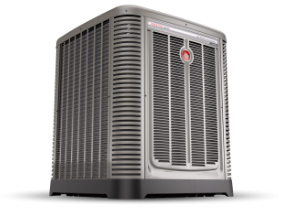
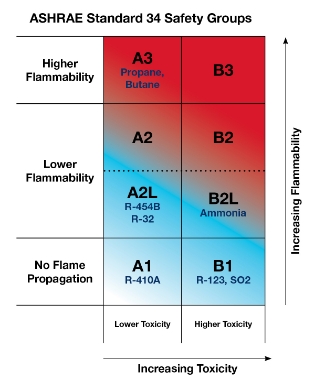
ENERGYGUIDE 101
The FTC (Federal Trade Commission) first issued an Energy Labeling Rule in 1979. The Rule
requires manufacturers of major home appliances to attach yellow EnergyGuide Labels to products
and post label information to supporting brochures and websites.

Consumers should use EnergyGuide Labels to comparison shop for the best in energy-efficient
solutions.
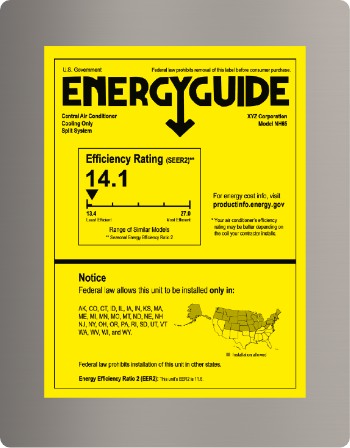
Split System Air Conditioner,
Cooling Only, Northern States
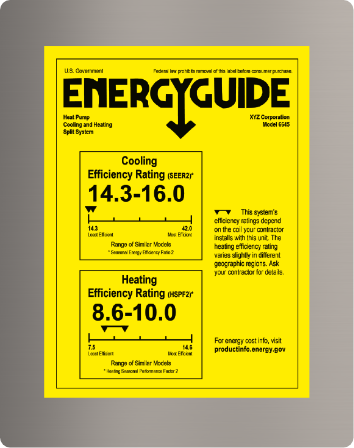
Split System Heat Pump,
Cooling & Heating, All States
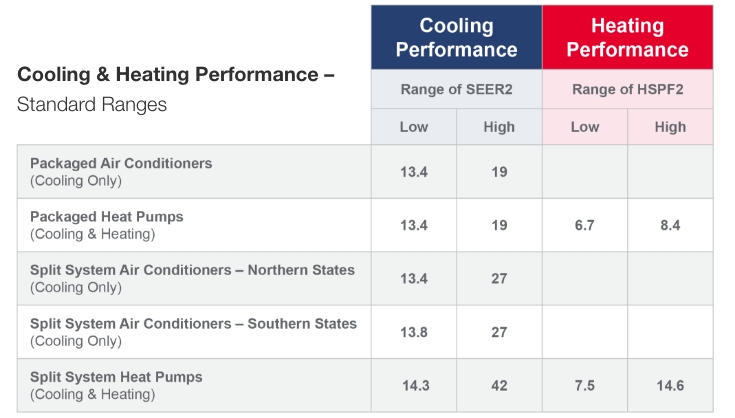

When it comes to training and certifications, everyone connected to the HVAC industry benefits
—contractors, technicians and even homeowners. North American Technician Excellence (NATE) is the
nation’s largest nonprofit certification organization for heating, ventilation, air conditioning and
refrigeration (HVACR) technicians. Headquartered in Arlington, VA, NATE was developed by and has
been supported by the industry for over 20 years.
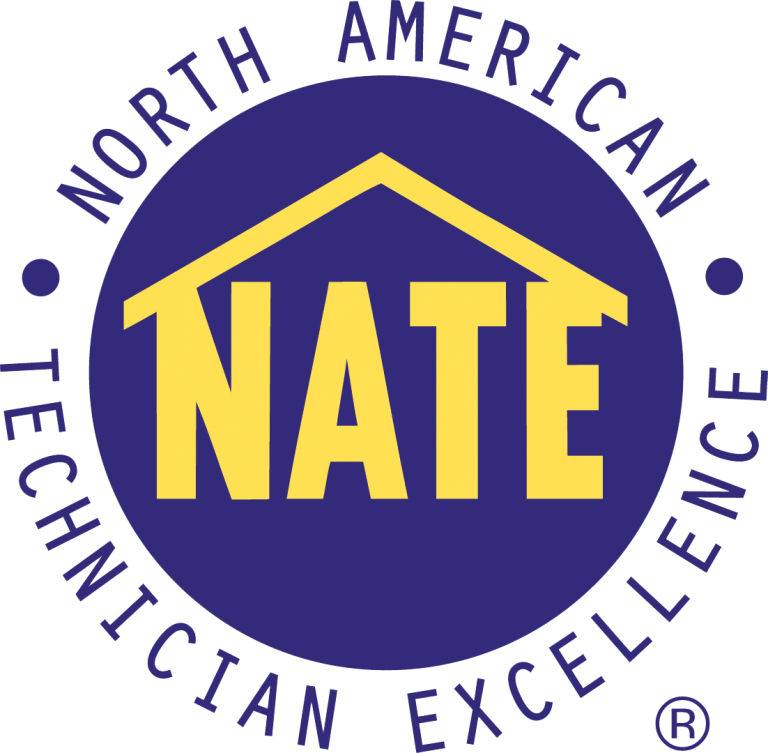
What Is the NATE Program & Who Is It For? Developed by a committee of industry
experts, the NATE program is a series of exams that result in either certificates or full
certifications and is designed for contractors and technicians of all experience levels. The
entry-level tests, Ready-to-Work and HVAC Support are intended for those with less than 12 months of
experience. Those who pass the tests earn a certificate, that identifies them as someone
knowledgeable and trained in the field. More rigorous exams are required to receive a full NATE
certification. Who is Eligible for Full NATE Certification & What Does It Entail?
NATE certification is recommended for contractors and technicians with two or more years of
experience. There are two certification testing pathways available: the Certified HVAC Professional
(CHP-5) pathway, a series of five exams, or the Core and Specialty exam pathway, a series of two
exams. For more information on either of these pathways, visit the NATE website. Are There Training Courses Available to
Help with Exam Preparation? NATE has partnered with lnterPlay Learning to launch NATE Training Academy, which allows contractors and technicians to train for
NATE certification exams online when convenient for them. The online training includes 3D and VR
simulations that mimic in-field experience. Contractors and technicians can start prepping for
NATE’s Certified HVAC Professional exam today. Additionally, this fall, training will be available
for NATE’s Low-GWP refrigeration certification.